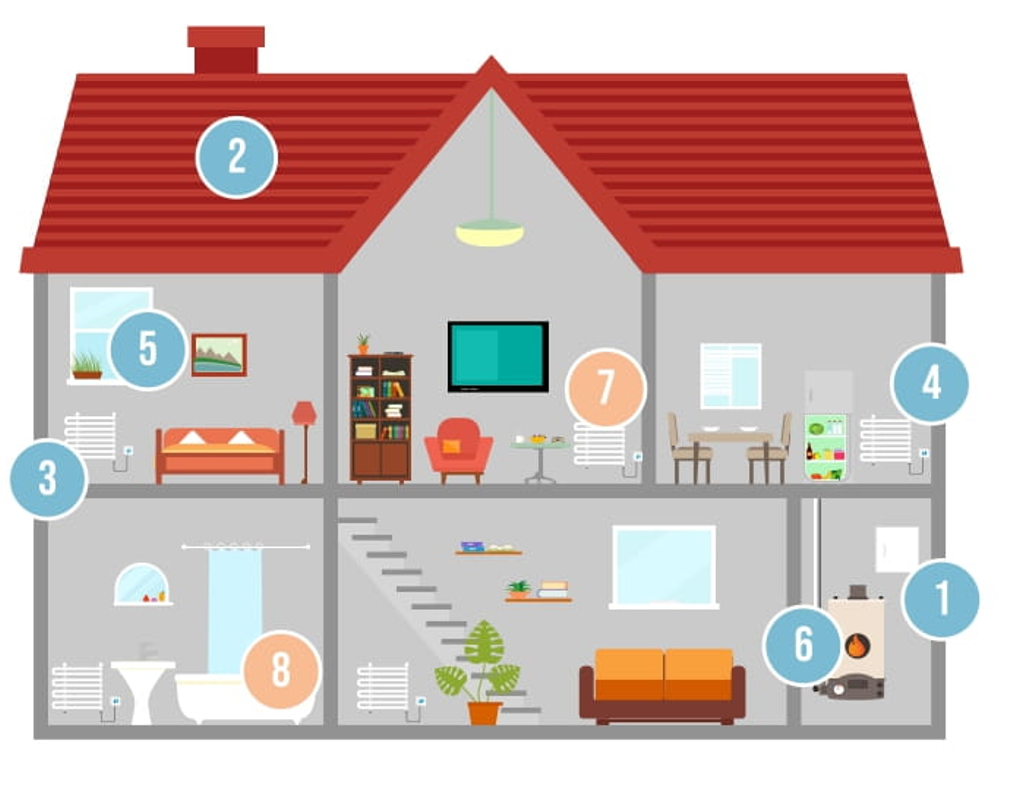-
12 East Street, Whitburn, SR6 7BX
-
0191 406 5300
-
info@highlyefficientheating.com
Energy efficiency measures and heat distribution explained
ENERGY EFFICIENCY MEASURES AND HEAT DISTRIBUTION EXPLAINED
Reducing underlying energy demand through increasing energy efficiency will be critical in achieving net-zero targets. Installing energy efficiency measures in homes and buildings has an up-front cost but reduces energy demand and carbon emissions. Some energy efficiency measures are simple to install and pay for themselves quickly, these should be installed in combination with any heating system replacement. For example, thermostatic radiator valves, smart thermostats and draught-proofing interventions fall into this category.
The diagram and below text outlines some of the key measures and solutions that can be installed or improved within a home in order to provide better energy efficiency. Whilst not all solutions highlighted will be an appropriate or achievable solution for all properties, they demonstrate the range of measures that can be taken.
1. Draught-proofing — Draught-proofing is one of the cheapest and most effective ways to save energy —and money — in any type of building. Draughts are uncontrolled and let in too much cold air and waste too much heat. Saving warm air means less energy required to heat a home, so draught-proofing will save money and ensure greater energy efficiency.2. Roof/loft insulation — A quarter of heat is lost through the roof in an uninsulated home. Insulating the loft, attic or flat roof is an effective way to reduce heat loss and reduce heating bills. Installed correctly, loft insulation should pay for itself many times over in its 40 year lifetime.
3. Solid wall insulation — Nearly one third of homes in the UK were built with brick and stone solid walls, most of which remain uninsulated due to the costs and disruption caused by the installation of solid wall This typically involves installing cladding on the exterior of the building, which fundamentally changes the aesthetic of the property and may require planning permission. It may also require installing insulation on the interior face of the walls which can be disruptive, but could also help to prevent damp, increase sound resistance and improve weatherproofing. Disruption can also be minimised if installation is done in conjunction with other measures.
4. Cavity wall insulation — Insulation of cavity walls is a non-intrusive measure which has a major impact on heat lost through the walls. Over two-third of homes in the UK were built with cavity walls, and in nearly 35% of these, there is no evidence of insulation being installed.
5. Insulating tanks and pipes — Insulating water tanks, pipes and radiators is a quick and easy way to save money on bills. Lagging water tanks and pipes and insulating behind radiators reduces the amount of heat lost, so less money is spent heating water up, and hot water stays hotter for longer.
6. Double glazing — Energy efficient glazing covers both double and triple glazing. These are windows with two or more glass panes in a sealed unit. Energy efficiency of a home can be improved by installing secondary glazing, or even by using heavy curtains. Having energy efficient windows could help to reduce carbon footprints and energy bills.
7. Radiators — To accommodate the lower temperature from a heat pump more radiators or radiators with larger surface areas will be needed to produce the same level of comfort.
8. Underfloor heating — As an alternative to increasing the surface area of wall mounted radiators, underfloor heating can be used. This involves under-laying the floor with a hot element or tubing that transfers heat into the room.


